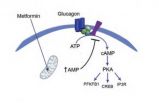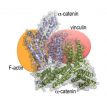How the kilogram has put on weight
2013-01-07
(Press-News.org) Post-Christmas and most of us are feeling the over-indulgence. But take heart - experts at Newcastle University, UK, have shown even the kilogram itself has put on weight. Using a state-of-the-art Theta-probe XPS machine – the only one of its kind in the world – the team have shown the original kilogram is likely to be tens of micrograms heavier than it was when the first standard was set in 1875.
And they say a suntan could be the key to helping it lose weight.
The original kilogram – known as the International Prototype Kilogram or the IPK – is the standard against which all other measurements of mass are set. Stored in the International Bureau of Weights and Measures in Paris, forty official replicas of the IPK were made in 1884 and distributed around the world in order to standardise mass. The UK holds replica 18 at the National Physical Laboratory (NPL).
But despite efforts to protect the IPK and its duplicates, industrialisation and modern living have taken their toll on the platinum-based weights and contaminants have built up on the surface. Now Professor Peter Cumpson and Dr Naoko Sano have used cutting-edge X-ray Photoelectron Spectroscopy (XPS) to analyse surfaces similar to the standard kilogram to assess the build-up of hydrocarbons – and how to remove them.
Publishing their findings this month in the journal of Metrologia, they reveal how giving the kilogram a suntan could be the answer to helping it lose weight. "Statute decrees the IPK is the kilogram," explains research lead Peter Cumpson, Professor of MicroElectroMechanical Systems (MEMS) at Newcastle University. "It doesn't really matter what it weighs as long as we are all working to the same exact standard - the problem is there are slight differences. Around the world, the IPK and its 40 replicas are all growing at different rates, diverging from the original.
"We're only talking about a very small change – less than 100 micrograms – so, unfortunately, we can't all take a couple of kilograms off our weight and pretend the Christmas over-indulgence never happened.
"But mass is such a fundamental unit that even this very small change is significant and the impact of a slight variation on a global scale is absolutely huge. There are cases of international trade in high-value materials - or waste - where every last microgram must be accounted for.
"What we have done at Newcastle is effectively give these surfaces a suntan. By exposing the surface to a mixture of UV and ozone we can remove the carbonaceous contamination and potentially bring prototype kilograms back to their ideal weight."
The kilogram is one of the seven SI base units from which all other units can be derived and is the only one which is measured against a physical object – the IPK – all others are standardised against known constants.
The Newcastle team are now moving on to study the addition of mercury from the atmosphere, something Professor Cumpson first identified while working at the NPL in the 1990's. But it is the development of techniques such as XPS which has allowed them to accurately measure how the build up of chemicals such as hydrocarbons can be most effectively removed.
Newcastle University hosts the £3million National XPS service funded by the Engineering and Physical Sciences Research Council (EPSRC).
Using a Theta-probe XPS machine – the only one of its kind in the world - Professor Cumpson and Dr Sano showed how the UV/ozone wash could be used to remove contamination without damaging the platinum surface. "The Theta probe allows us to look at the composition of very thin layers by measuring the angle at which the electrons emerge from it," explains Professor Cumpson.
"Rather like an MRI scanner, it takes a cross section of the material but at an atomic level. The second part of the machine is the Argon cluster ion gun – which fires charged 'droplets', each containing about a thousand Argon atoms – and it is this which makes the Newcastle machine unique.
"The Argon cluster ion gun allows us to analyse organic materials without damaging the inorganic surface, in this case the platinum alloy."
Work is underway internationally in several National Measurement Institutes to find an alternative to the IPK – a standardised value for the kilogram that is not based on a matchbox- sized piece of metal. But until then, the prototype kilograms are what the world relies on for its mass scale.
"If the kilogram does put on weight then it's imperative that we understand exactly how the IPK is changing," says Professor Cumpson.
### END
ELSE PRESS RELEASES FROM THIS DATE:
New antimatter method to provide 'a major experimental advantage'
2013-01-07
Researchers have proposed a method for cooling trapped antihydrogen which they believe could provide 'a major experimental advantage' and help to map the mysterious properties of antimatter that have to date remained elusive.
The new method, developed by a group of researchers from the USA and Canada, could potentially cool trapped antihydrogen atoms to temperatures 25 times colder than already achieved, making them much more stable and a lot easier to experiment on.
The suggested method, which has been published today, 7 January 2013, in IOP Publishing's Journal of ...
Most-used diabetes drug works in different way than previously thought
2013-01-07
PHILADELPHIA - A team, led by senior author Morris J. Birnbaum, MD, PhD, the Willard and Rhoda Ware Professor of Medicine, with the Institute for Diabetes, Obesity, and Metabolism, Perelman School of Medicine, University of Pennsylvania, found that the diabetes drug metformin works in a different way than previously understood. Their research in mice found that metformin suppresses the liver hormone glucagon's ability to generate an important signaling molecule, pointing to new drug targets. The findings were published online this week in Nature.
For fifty years, one ...
Genetic mystery of Behcet's disease unfolds along the ancient Silk Road
2013-01-07
Researchers have identified four new regions on the human genome associated with Behcet's disease, a painful and potentially dangerous condition found predominantly in people with ancestors along the Silk Road. For nearly 2,000 years, traders used this 4,000-mile network linking the Far East with Europe to exchange goods, culture and, in the case of the Silk Road disease, genes. National Institutes of Health researchers and their Turkish and Japanese collaborators published their findings in the Jan. 6, 2013, advance online issue of Nature Genetics.
Named for the Turkish ...
From the Amazon rainforest to human body cells: Quantifying stability
2013-01-07
As they typically result from severe external perturbations, it is of vital interest how stable the most desirable state is. Surprisingly, this basic question has so far received little attention. Now scientists of the Potsdam Institute for Climate Impact Research (PIK), in a paper published in Nature Physics, propose a new concept for quantifying stability.
"Up to now, science was able to say if a complex system is stable or not, but it wasn't able to properly say how stable it is," says Peter J. Menck, lead author of the paper. The proposed concept is the first to fill ...
A new approach to assessing future sea level rise from ice sheets
2013-01-07
The study, published today in Nature Climate Change, is the first of its kind on ice sheet melting to use structured expert elicitation (EE) together with an approach which mathematically pools experts' opinions. EE is already used in a number of other scientific fields such as forecasting volcanic eruptions.
The ice sheets covering Antarctica and Greenland contain about 99.5 per cent of the Earth's glacier ice which would raise global sea level by some 63m if it were to melt completely. The ice sheets are the largest potential source of future sea level rise – and ...
The pain puzzle: Uncovering how morphine increases pain in some people
2013-01-07
Quebec City & Toronto, January 6, 2013—For individuals with agonizing pain, it is a cruel blow when the gold-standard medication actually causes more pain. Adults and children whose pain gets worse when treated with morphine may be closer to a solution, based on research published in the January 6 on-line edition of Nature Neuroscience.
"Our research identifies a molecular pathway by which morphine can increase pain, and suggests potential new ways to make morphine effective for more patients," says senior author Dr. Yves De Koninck, Professor at Université Laval in ...
New study defines the long-sought structure of a protein necessary for cell-cell interaction
2013-01-07
JUPITER, FL, January 6, 2012 – Scientists know that cells in all higher organisms cells need to bind to each other for the development, architecture, maintenance and function of tissues. Mysteries have remained, however, about exactly how cells manage this feat.
Scientists from the Florida campus of The Scripps Research Institute (TSRI) have now solved part of this puzzle by defining the structure of a protein known as α-catenin, which is essential to this process.
The work was published online ahead of print on January 6, 2012, by the journal Nature Structural ...
Joslin researchers identify important factor in fat storage and energy metabolism
2013-01-07
BOSTON – January 8, 2013 -- As part of their ongoing research on the physiologic factors that contribute to the development of obesity, Joslin Diabetes Center scientists have identified a cell cycle transcriptional co-regulator – TRIP-Br2 – that plays a major role in energy metabolism and fat storage. This finding has the potential to lead to new treatments for obesity. The study is being published today ahead of print by Nature Medicine.
Transcriptional co-regulators manage the expression of DNA, either by activating or suppressing the expression of genes. TRIP-Br2 ...
Astrophysicists find wide binary stars wreak havoc in planetary systems
2013-01-07
VIDEO:
This movie shows two simulations of planetary system disruption by galactic disturbances to wide binary stars. On the left is a zoomed-out view showing the orbit of a hypothetical 0.1...
Click here for more information.
TORONTO, ON – An international team of astrophysicists has shown that planetary systems with very distant binary stars are particularly susceptible to violent disruptions, more so than if they had stellar companions with tighter orbits around them.
Unlike ...
Study reveals ordinary glass's extraordinary properties
2013-01-07
Technologically valuable ultrastable glasses can be produced in days or hours with properties corresponding to those that have been aged for thousands of years, computational and laboratory studies have confirmed.
Aging makes for higher quality glassy materials because they have slowly evolved toward a more stable molecular condition. This evolution can take thousands or millions of years, but manufacturers must work faster. Armed with a better understanding of how glasses age and evolve, researchers at the universities of Chicago and Wisconsin-Madison raise the possibility ...



